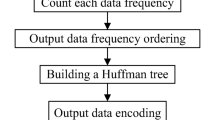Abstract
Advanced telemedicine requires the gathering of big data through wireless body area network or internet of things based applications. These networks perform several tasks that consume maximum energy while transmitting the big data, which in turn discharges the battery and would require a battery replacement frequently. Also, the big data to be transferred and stored would require a significant amount of storage space. The above problem is rectified by compressing the big data acquired from the sensors before transmission that would reduce the consumption of power as well as use the storage space efficiently. In this paper, a hybrid compression algorithm (HCA) based on Rice Golomb Coding is proposed. The efficiency of the proposed compression algorithm is tested on ECG data from the physionet ATM database and real-time data acquired from the ECG sensor. The proposed HCA comprises of both lossy and lossless compression. The real-time implementation of the proposed compression algorithm is carried out using NI myRIO hardware and LabVIEW graphical tool. The compressed data then stored in the Google cloud, and the analysis of storage space using the HCA shows a reduction of 70% storage space for 10 minutes of ECG data.
















Similar content being viewed by others
References
Elgendi, M. (2018). Less is more in biosignal analysis: Compressed data could open the door to faster and better diagnosis. Diseases. https://doi.org/10.3390/diseases6010018.
Tornekar, R. V., & Gajre, S. S. (2017). Comparative study of lossless ECG signal compression techniques for wireless networks. Computing in Cardiology. https://doi.org/10.22489/cinc.2017.095-236.
Mitra, S., & Das, D. (2017). A critical study on the applications of run-length encoding techniques in combined encoding schemes. International Journal of Advanced Research in Computer Science,8(5), 2556–2561.
Elgendi, M., Mohamed, A., & Ward, R. (2017). Efficient ECG compression and QRS detection for e-health applications. Scientific Reports. https://doi.org/10.1038/s41598-017-00540-x.
Kalaivani, S., & Tharini, C. (2018). Analysis and modification of rice golomb coding lossless compression algorithm for wireless sensor networks. Journal of Theoretical And Applied Information Technology,96(12), 3802–3814.
Sun, C.-C., & Tai, S.-C. (2005). Beat-based ECG compression using gain-shape vector quantization. IEEE Transaction on Biomedical Engineering,52, 1882–1888.
Rasool, U., Mairaj, S., Nazeer, T., & Ahmed, S. (2017). Wavelet-based image compression techniques: comparative analysis and performance evaluation. International Journal of Emerging Technologies in Engineering Research (IJETER),5(9), 9–13.
Chouakri, S. A., Benaiad, M. M., & Taleb Ahmed, A. (2011). Run-length encoding and Wavelet transform-based ECG compression algorithm for transmission via IEEE802.11b WLAN channel. In ACM digital library, proceedings of the 4th international symposium on applied sciences in biomedical and communication technologies, Article No. 37, Barcelona, Spain, October 26–29, 2011.
Javaid, R., Besar, R., & Abas, F. S. (2017). Performance evaluation of percent root mean square difference for ECG signals compression. An International Journal on Signal Processing,48, 1–9.
Tan, C., Zhang, L., & Wu, H.-T. (2019). A novel blaschke unwinding adaptive-fourier-decomposition-based signal compression algorithm with application on ECG signals. IEEE Journal of Biomedical and Health Informatics,23(2), 672–682.
Burguera, A. (2019). Fast QRS detection and ECG compression based on signal structural analysis. IEEE Journal of Biomedical and Health Informatics,23(1), 123–131.
Tsai, T.-H., & Kuo, W.-T. (2018) An efficient ECG lossless compression system for embedded platforms with telemedicine applications. In IEEE.
Huang, H., Hu, S., & Sun, Y. (2018). ECG signal compression for low-power sensor nodes using sparse frequency spectrum features. In IEEE biomedical circuits and systems conference (BioCAS).
Deepu, C. J., Heng, C.-H., & Lian, Y. (2017). A hybrid data compression scheme for power reduction in wireless sensors for IoT. IEEE Transactions on Biomedical Circuits and Systems,11(2), 245–254.
Jha, C. K., & Kolekar, M. H. (2017). ECG data compression algorithm for telemonitoring of cardiac patients. International Journal of Telemedicine and Clinical Practices,2(1), 31–41.
Lu, X., Pan, M., Yu, Y. (2018). QRS detection based on improved adaptive threshold. Journal of Healthcare Engineering,2018, Article ID 5694595.
Kalaivani, S., Shahnaz, I., Shirin, S. R., & Tharini, C. (2016). Real-time ECG acquisition and detection of anomalies. In Dash, S. S., Bhaskar, M. A., Panigrahi, B. K., Das, S (Eds.), Artificial intelligence and evolutionary computations in engineering systems. Springer.
Uthayakumar, J., Venkattaraman, T., & Dhayachelvan, P. (2018). A survey on data compression techniques: From the perspective of data quality, coding schemes, data types and applications. Journal of King Saud University- Computer and Information Sciences. https://doi.org/10.1016/j.jksuci.2018.05.006.
https://physionet.org/cgibin/atm/ATM?database=mitdb&tool=plot_waveforms.
Author information
Authors and Affiliations
Corresponding author
Additional information
Publisher's Note
Springer Nature remains neutral with regard to jurisdictional claims in published maps and institutional affiliations.
Rights and permissions
About this article
Cite this article
Kalaivani, S., Tharini, C., Saranya, K. et al. Design and Implementation of Hybrid Compression Algorithm for Personal Health Care Big Data Applications. Wireless Pers Commun 113, 599–615 (2020). https://doi.org/10.1007/s11277-020-07241-1
Published:
Issue Date:
DOI: https://doi.org/10.1007/s11277-020-07241-1




